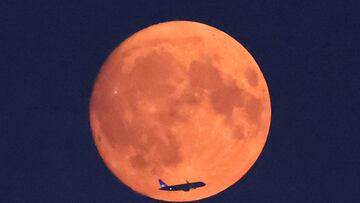Why is the blue moon called the sturgeon moon?
Stargazers will be looking forward to looking up at the night sky this Monday with the first of four super moons that will also be a blue moon.

If the skies are clear where you are you won’t want to miss the first of four super moons that will be at its most splendid on Monday night. That’s because it will also be a blue moon, a rare occurrence. But don’t worry if Monday is cloudy, it will still be impressive through Wednesday morning.
That’s because on average, supermoons appear about 7 percent bigger and about 15 percent brighter than a typical full moon. Compared to the moon at its faintest, a supermoon is roughly 14 percent bigger and 30 percent brighter. The next full moon, called the Sturgeon Moon, will reach its peak fullness on Monday, August 19, at 2:26 p.m. ET.
Follow Monday’s super blue full moon live updates
Why is the blue moon called the sturgeon moon?
Many of the terms commonly used for full moons given in The Old Farmer’s Almanac have roots in Native American, Colonial American and European cultures. Typically the name applied to a full moon was also used to describe the entire lunar month in which it occurred.
Set to be a blue moon and this year’s first supermoon, Monday evening’s sturgeon moon will appear bigger and brighter in the evening sky.
— US Department of the Interior (@Interior) August 18, 2024
From @joshuatreenps to @acadianps, America’s public lands are ideal places for watching celestial wonders!
Photo by Brad Sutton / NPS pic.twitter.com/Nk6HWueqE5
The sturgeon moon is commonly used for the August lunar cycle and is so named because of the huge fish found in the Great Lakes, Lake Chaplain and Lake Winnebago. Giant sturgeon could be most easily caught during late summer and it became a valuable source of protein for locals.
The blue moon moniker is given to the second consecutive full moon in the same month, or as is the case with this sturgeon moon, the third of four full moons in an astronomical season. Depending on what time you see the moon and the atmospheric conditions, it will most likely appear a deep red or orange when it is low on the horizon before becoming an intense radiant white.
As for why it is a super moon, they occur when the moon is full at the same time as its closest approach to Earth in its elliptical orbit, or perigee. A full moon is considered a supermoon, not an official astronomical term, when it comes within 90 percent of perigee. They always appear consecutively three or four times a year.
Related stories
Catching sight of the event as it comes into view will make it seem even bigger than it really is thanks to the ‘big moon illusion’. To know exactly where it will appear on the horizon there is an online application MoonCalc, which will come in useful if you want to take a picture.
How to take a picture of the Super Blue Moon?
If you are looking to catch the perfect photo of the supermoon there are some tools that can help you. For your smartphone there is a useful app, PhotoPills, available for iOS and Android. So that you can make the most of using the app PetaPixel gives a walk through of the app’s features.



Complete your personal details to comment